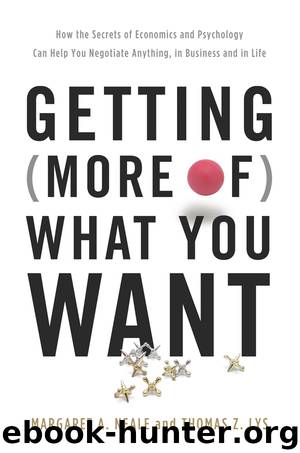Getting (More Of) What You Want : How the Secrets of Economics and Psychology Can Help You Negotiate Anything, in Business and in Life (9780465040636) by Neale Margaret A.; Lys Thomas Z

Author:Neale, Margaret A.; Lys, Thomas Z.
Language: eng
Format: mobi, epub
Publisher: Perseus Book Group
Published: 2015-08-13T15:52:18+00:00
CHAPTER NINE
CONCEDE OR ELSE!
The Influence of Promises and Threats
Negotiators often attempt to influence their counterparts by issuing threats or making promises. For example, they might threaten to walk away if their counterpart does not concede on an issue, or even threaten to take an action that is outside the negotiation; for example, unions typically threaten to strike, thereby imposing costs on management if they don’t concede. On the other hand, negotiators also may promise to take an action that is outside the temporal frame of your current negotiation, such as: “If you concede on this issue, I will make sure that everyone knows what a great product you sell.”
In this chapter, we focus on promises and threats of actions that occur after the negotiation has concluded as forms of influence. Thus, when the target of the threat or promise concedes, he does not know if the issuer will actually carry out the threat or honor the promise.
Obviously, to be effective at influencing the target, promises and threats have to be credible; that is the target must believe that, if he concedes, the issuer will make good on the promise—or carry out the threat, if he does not. Conversely, if the target believes that the threat or the promise is not credible (i.e., that it will not be carried out), then he should simply ignore that threat or promise. Of course, it also follows that issuers should only threaten or promise when those actions are perceived as credible by the target and thus likely to have the desired influence.
We’ll begin by discussing the differences and the similarities between threats and promises. Then we focus on what makes promises and threats credible. We start with the assumption that both issuer and target act reasonably (or in Thomas’s view, rationally). We will then expand our analysis to include the psychological perspective.
PROMISES VERSUS THREATS
Both threats and promises are used to influence your behavior. For example, airlines routinely promise their best customers access to seats with more legroom and upgrades to first class. Those promises are contingent on availability and, thus, not really enforceable—yet these benefits are effective in influencing customers’ behavior only if they believe that the airline will make good on that promise. It is the same in a negotiation; promises are useful to the extent that you believe that your counterpart will honor her promises.
Just as in the case of promises where your counterpart can offer attractive inducements, she may threaten some other action that is costly to you if you do not concede. However, from your perspective (as the target of the action), an obvious difference between threats and promises is that if carried out, threats impose costs on you while promises offer benefits.
Carrying out either a threat or a promise, however, is costly to the issuer. Indeed, although it seems natural to focus on the costs and benefits from the perspective of the target of these attempts to influence, as we discuss next, what matters most for the credibility of the threats and promises themselves are actually the costs from the perspective of the issuer.
Download
Getting (More Of) What You Want : How the Secrets of Economics and Psychology Can Help You Negotiate Anything, in Business and in Life (9780465040636) by Neale Margaret A.; Lys Thomas Z.epub
This site does not store any files on its server. We only index and link to content provided by other sites. Please contact the content providers to delete copyright contents if any and email us, we'll remove relevant links or contents immediately.
Nudge - Improving Decisions about Health, Wealth, and Happiness by Thaler Sunstein(7237)
Deep Work by Cal Newport(6558)
Principles: Life and Work by Ray Dalio(5953)
The Doodle Revolution by Sunni Brown(4498)
Factfulness: Ten Reasons We're Wrong About the World – and Why Things Are Better Than You Think by Hans Rosling(4483)
Eat That Frog! by Brian Tracy(4147)
Thinking in Bets by Annie Duke(3995)
Hyperfocus by Chris Bailey(3899)
Visual Intelligence by Amy E. Herman(3619)
Writing Your Dissertation in Fifteen Minutes a Day by Joan Bolker(3571)
How to Win Friends and Influence People in the Digital Age by Dale Carnegie & Associates(3361)
Ogilvy on Advertising by David Ogilvy(3324)
Hidden Persuasion: 33 psychological influence techniques in advertising by Marc Andrews & Matthijs van Leeuwen & Rick van Baaren(3290)
How to win friends and influence people by Dale Carnegie(3266)
The Pixar Touch by David A. Price(3203)
Schaum's Quick Guide to Writing Great Short Stories by Margaret Lucke(3182)
Deep Work: Rules for Focused Success in a Distracted World by Cal Newport(2977)
Work Clean by Dan Charnas(2887)
The Slow Fix: Solve Problems, Work Smarter, and Live Better In a World Addicted to Speed by Carl Honore(2837)
